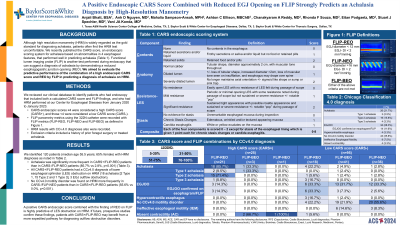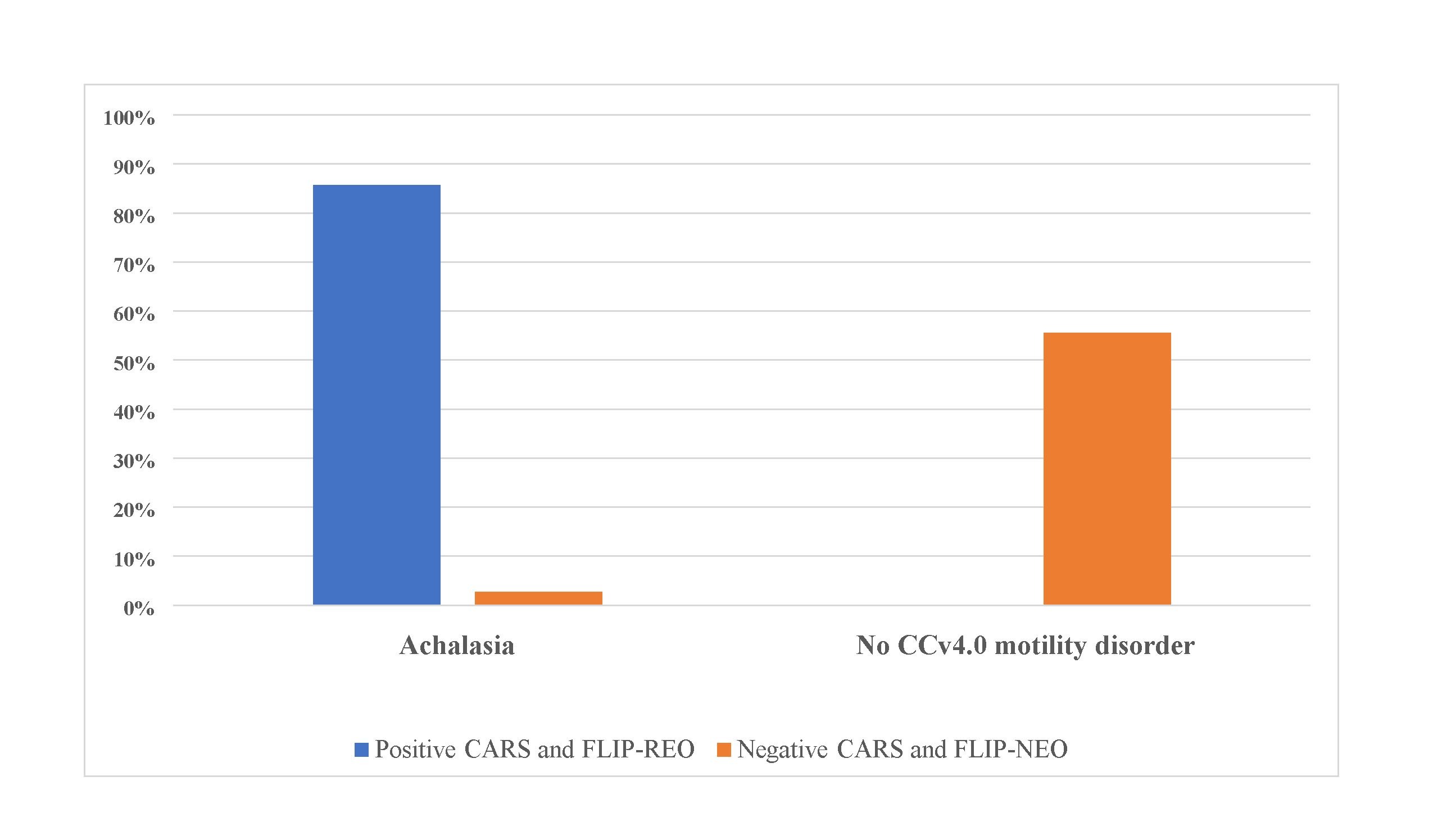Sunday Poster Session
Category: Esophagus
P0504 - A Positive Endoscopic CARS Score Combined With Reduced EGJ Opening on FLIP Strongly Predicts an Achalasia Diagnosis by High Resolution Manometry
Sunday, October 27, 2024
3:30 PM - 7:00 PM ET
Location: Exhibit Hall E

Has Audio
- AB
Anjali Bhatt, BS
Texas A&M School of Medicine
Sugar Land, TX
Presenting Author(s)
Anjali Bhatt, BS1, Anh D.. Nguyen, MD2, Mahalia Sampson-Ansah, MPH3, Ashton Ellison, MBBCh2, Chanakyaram A.. Reddy, MD4, Rhonda F.. Souza, MD5, Eitan Podgaetz, MD4, Stuart J.. Spechler, MD2, Vani J.A.. Konda, MD2
1Texas A&M School of Medicine, Sugar Land, TX; 2Baylor University Medical Center and Center for Esophageal Research, Baylor Scott & White Research Institute, Dallas, TX; 3Center for Esophageal Diseases, Baylor University Medical Center, Dallas, TX; 4Center for Esophageal Diseases, Baylor Scott & White Medical Center, Dallas, TX; 5Baylor Scott & White Research Institute, Dallas, TX
Introduction: Although high resolution manometry (HRM) is widely regarded as the gold standard for diagnosing achalasia, patients often find the HRM test unpleasant. We recently reported development of the CARS score [an endoscopic scoring system for achalasia based on abnormalities in 4 esophageal features (Contents, Anatomy, Resistance at the LES, and Stasis)] that performed well in predicting achalasia. Functional lumen imaging probe (FLIP) is another test performed during endoscopy that can suggest a diagnosis of achalasia by revealing reduced esophagogastric junction opening (REO). We aimed to evaluate the predictive performance of the combination of a positive endoscopic CARS score and REO by FLIP in predicting a diagnosis of achalasia on HRM.
Methods: We reviewed our clinical database to identify patients who had endoscopy that included both a calculated CARS score and FLIP findings, and who had HRM performed at our Center for Esophageal Diseases from January 2020 to January 2023. CARS endoscopic scores ≥4 were considered positive (CARS+), and those < 4 were considered negative (CARS-). FLIP panometry metrics using the 322N catheter were recorded with FLIP-REO defined as EGJ-diameter < 12 mm (max volume at 60 or 70mL) and EGJ-distensibility index (DI) < 2 mm2/mmHg at 60mL and normal EGJ opening (FLIP-NEO) defined as EGJ diameter >16 mm (max volume at 60 or 70mL) and EGJ-DI >2 mm2/mmHg at 60mL. HRM results with CCv.4.0 diagnoses also were recorded. Exclusion criteria included a history of prior foregut surgery or treated achalasia.
Results: We identified 118 patients (median age 57.5 years; 65% female); 21 were CARS+ with FLIP-REO and 36 were CARS- with FLIP-NEO. Achalasia was significantly more frequent in CARS+/FLIP-REO patients than in CARS-/FLIP-NEO patients (85.7% vs 2.8%, p< 0.001) (Figure 1). Furthermore, all CARS+/FLIP-REO patients had a CCv4.0 diagnosis of LES obstruction on HRM (18 achalasia [2 Type 1, 15 Type 2 and 1 Type 3], 3 EGJ outflow obstruction). In contrast, no CCv4.0 motility disorder was found on HRM more frequently in CARS-/FLIP-NEO patients than in CARS+/FLIP-REO patients (55.6% vs 0.0%, p< 0.001).
Discussion: A positive CARS endoscopic score combined with the finding of REO on FLIP is highly predictive of an achalasia diagnosis on HRM. If future, prospective studies confirm these findings, CARS+/FLIP-REO patients might be treated for achalasia without the need to confirm the diagnosis by HRM.

Disclosures:
Anjali Bhatt, BS1, Anh D.. Nguyen, MD2, Mahalia Sampson-Ansah, MPH3, Ashton Ellison, MBBCh2, Chanakyaram A.. Reddy, MD4, Rhonda F.. Souza, MD5, Eitan Podgaetz, MD4, Stuart J.. Spechler, MD2, Vani J.A.. Konda, MD2. P0504 - A Positive Endoscopic CARS Score Combined With Reduced EGJ Opening on FLIP Strongly Predicts an Achalasia Diagnosis by High Resolution Manometry, ACG 2024 Annual Scientific Meeting Abstracts. Philadelphia, PA: American College of Gastroenterology.
1Texas A&M School of Medicine, Sugar Land, TX; 2Baylor University Medical Center and Center for Esophageal Research, Baylor Scott & White Research Institute, Dallas, TX; 3Center for Esophageal Diseases, Baylor University Medical Center, Dallas, TX; 4Center for Esophageal Diseases, Baylor Scott & White Medical Center, Dallas, TX; 5Baylor Scott & White Research Institute, Dallas, TX
Introduction: Although high resolution manometry (HRM) is widely regarded as the gold standard for diagnosing achalasia, patients often find the HRM test unpleasant. We recently reported development of the CARS score [an endoscopic scoring system for achalasia based on abnormalities in 4 esophageal features (Contents, Anatomy, Resistance at the LES, and Stasis)] that performed well in predicting achalasia. Functional lumen imaging probe (FLIP) is another test performed during endoscopy that can suggest a diagnosis of achalasia by revealing reduced esophagogastric junction opening (REO). We aimed to evaluate the predictive performance of the combination of a positive endoscopic CARS score and REO by FLIP in predicting a diagnosis of achalasia on HRM.
Methods: We reviewed our clinical database to identify patients who had endoscopy that included both a calculated CARS score and FLIP findings, and who had HRM performed at our Center for Esophageal Diseases from January 2020 to January 2023. CARS endoscopic scores ≥4 were considered positive (CARS+), and those < 4 were considered negative (CARS-). FLIP panometry metrics using the 322N catheter were recorded with FLIP-REO defined as EGJ-diameter < 12 mm (max volume at 60 or 70mL) and EGJ-distensibility index (DI) < 2 mm2/mmHg at 60mL and normal EGJ opening (FLIP-NEO) defined as EGJ diameter >16 mm (max volume at 60 or 70mL) and EGJ-DI >2 mm2/mmHg at 60mL. HRM results with CCv.4.0 diagnoses also were recorded. Exclusion criteria included a history of prior foregut surgery or treated achalasia.
Results: We identified 118 patients (median age 57.5 years; 65% female); 21 were CARS+ with FLIP-REO and 36 were CARS- with FLIP-NEO. Achalasia was significantly more frequent in CARS+/FLIP-REO patients than in CARS-/FLIP-NEO patients (85.7% vs 2.8%, p< 0.001) (Figure 1). Furthermore, all CARS+/FLIP-REO patients had a CCv4.0 diagnosis of LES obstruction on HRM (18 achalasia [2 Type 1, 15 Type 2 and 1 Type 3], 3 EGJ outflow obstruction). In contrast, no CCv4.0 motility disorder was found on HRM more frequently in CARS-/FLIP-NEO patients than in CARS+/FLIP-REO patients (55.6% vs 0.0%, p< 0.001).
Discussion: A positive CARS endoscopic score combined with the finding of REO on FLIP is highly predictive of an achalasia diagnosis on HRM. If future, prospective studies confirm these findings, CARS+/FLIP-REO patients might be treated for achalasia without the need to confirm the diagnosis by HRM.

Figure: Figure 1: Percent of patients with achalasia or no CCv4.0 motility disorder by HRM in CARS+/FLIP-REO vs CARS-/FLIP-NEO patients
Disclosures:
Anjali Bhatt indicated no relevant financial relationships.
Anh Nguyen indicated no relevant financial relationships.
Mahalia Sampson-Ansah indicated no relevant financial relationships.
Ashton Ellison indicated no relevant financial relationships.
Chanakyaram Reddy indicated no relevant financial relationships.
Rhonda Souza: Capsulomics – Consultant. Castle Biosciences Inc – Consultant. Lucid Diagnostics – Consultant. Phathom Pharmaceuticals – Consultant. Sanofi – Grant/Research Support.
Eitan Podgaetz indicated no relevant financial relationships.
Stuart Spechler: Castle Biosciences – Consultant. Lucid Diagnostics – Consultant. Phathom Pharmaceuticals – Consultant. Takeda Pharmaceuticals – Consultant.
Vani Konda: Castle – Speakers Bureau. Exact – Advisory Committee/Board Member, Consultant. Medtronic – Advisory Committee/Board Member, Consultant. Pentax – Consultant. sebela – Advisor or Review Panel Member, Consultant.
Anjali Bhatt, BS1, Anh D.. Nguyen, MD2, Mahalia Sampson-Ansah, MPH3, Ashton Ellison, MBBCh2, Chanakyaram A.. Reddy, MD4, Rhonda F.. Souza, MD5, Eitan Podgaetz, MD4, Stuart J.. Spechler, MD2, Vani J.A.. Konda, MD2. P0504 - A Positive Endoscopic CARS Score Combined With Reduced EGJ Opening on FLIP Strongly Predicts an Achalasia Diagnosis by High Resolution Manometry, ACG 2024 Annual Scientific Meeting Abstracts. Philadelphia, PA: American College of Gastroenterology.

